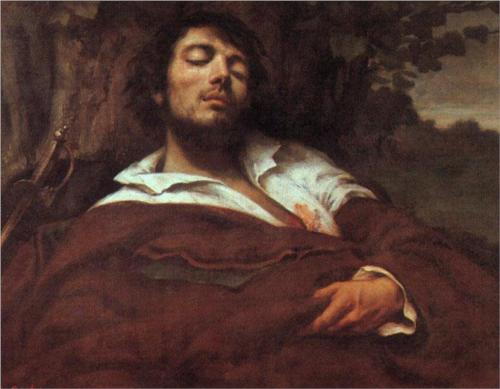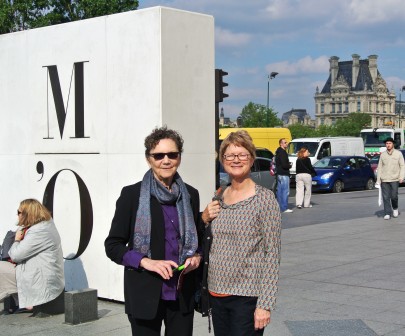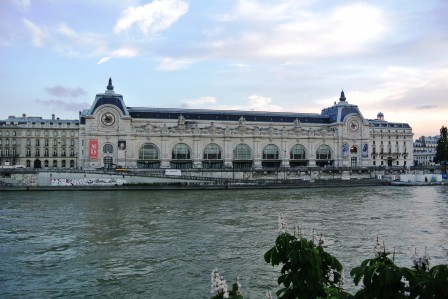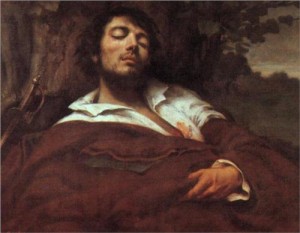The Musee d’Orsay is a 10 minute walk from our apartment. Armed with our Museum Pass, which gets you in through a side door and saves about an hour waiting in the “ticket purchase” line (due to the slow lines at security), we have been not once but twice. In Europe, May 18 was “Free Museum Night” with long hours, free admission, and dance and music in some of the museums. (Note:The d’Orsay does not allow photography of any kind. Thus my photos are exterior shots only. All other are stock photos.)
The Musee d’Orsay Is a wonderful space converted in 1986 from a former railway station, the Gare d’Orsay. It specializes in art from 1848-1942, and holds the world’s largest collection of Impressionist and Post-Impressionist works.
Built for the Universal Exhibition (World Fair) of 1900, the railway station showcased the Beaux Art style of architecture. Prior to the construction of the railway station, the site held government offices built in the early 19th c; they were burnt down along with the rest of the neighborhood in the violent civil war called the Paris Commune that broke out in Paris with the fall of Emperor Napoleon III in 1871. The site stood in ruins for the next 30 years, until a private company leased t the land to build a station. The new railway station served the rail needs of southwestern France and lasted until in 1939. When it then became too small to handle the larger trains coming into long-distance service, it was converted into a commuter train station. After several other uses in the 20th c, the Beaux Art station was slated for destruction in the 1970’s to make way for a large hotel. President Valéry Giscard d’Estaing decided to convert it instead to a new museum; the resulting museum d’Orsay opened in 1986.
I (Nancy) wanted to learn more about Gustave Courbet, the 19th c. artist.Though the Gaugin paintings and wood carvings in the d’Orsay were a close second for me.
We in the U.S. know a lot less about Courbet than about the French Impressionists. After the last 40 years of advertising, who wouldn’t recognize a Monet Water Lily?
Who was Gustave Courbet? Courbet was born in 1819, right after the end of the French Revolution-Napoleonic era in the region of France known as Franche-Comte, about 250 miles SE of Paris. His hometown, Ornans, lies between Dijon and Lausanne, Switzerland, on the banks of a tributary of the Doubs River. His father’s family was from the well-to-do landed gentry in this small town founded in the 6th c., though his mother’s family was publicly opposed to the Catholic Church ( an “anti-clerical”) during the Revolution. Her side “lost” when Napoleon was defeated at Waterloo in 1815, but with no apparent consequences for the family. As a child Courbet grew up believing he was a natural singer, but it’s more likely he was just a noisy wild-child. This would show up later in his love of self-portraiture. At Church, he confessed to sins so preposterous the Catholic priests refused him absolution .Although he loved drawing from an early age, his future, like other young people in the 19th century, was controlled by his father. Papa (sensibly) wanted him to study law–wealth and honor for the family was more likely to be forthcoming. Finally Papa relented and at the age of 21, Courbet got to move to Paris.
Paris in 1840 was heaven for a young man. Papa, immediately alarmed, berated son Gustave as having succumbed to a dissolute life in The Wicked City. But the errant son was also studying the Masters in the Louvre. He became interested in portraits and landscapes. Not surprising to us today, but a bit off the beaten track in his day, where subjects were usually literary ones or romantic, sentimental clap-trap. And wild though he may have been, he saw the necessity of submitting canvases to the government-sanctioned “Salons,” ruled by the Academy of Fine Arts: without the approval of the government-appointed taste-makers, an artist was unlikely to sell his art. He submitted, his canvasses were accepted in 1848, and some sold. Courbet was launched.
 France continued to have revolutions throughout the 19th c., –in 1830, in 1848, in 1870–and Courbet became known as a “democrat” and a “republican.” In art he was known as a Realist. The Realists though the artist should paint the everyday, the material, the rational, that backed by science and technology. Not for them Classicism, pursuing perfect Truth and Beauty and elegance; Nor Romanticism, fixated on sentimentality and unrestrained imagination beyond the realm of the material. Sometimes Courbet’s Realism produced the Shock of the Unpleasant; his “Bathers” of 1848 brought an outcry that the women were “disgustingly fat;” the Emperor Napoleon III, who preferred chic women, in disgust struck the painting with his riding crop.
France continued to have revolutions throughout the 19th c., –in 1830, in 1848, in 1870–and Courbet became known as a “democrat” and a “republican.” In art he was known as a Realist. The Realists though the artist should paint the everyday, the material, the rational, that backed by science and technology. Not for them Classicism, pursuing perfect Truth and Beauty and elegance; Nor Romanticism, fixated on sentimentality and unrestrained imagination beyond the realm of the material. Sometimes Courbet’s Realism produced the Shock of the Unpleasant; his “Bathers” of 1848 brought an outcry that the women were “disgustingly fat;” the Emperor Napoleon III, who preferred chic women, in disgust struck the painting with his riding crop.
But he persisted and by 1861, twenty years after he started, he had achieved considerable prestige, even if the government and the “official” art establishment still considered him a pest.He loved women, many women, usually his models, and never married. He wrote: ” My love will not stretch far enough to include a journey with a woman. Knowing there are women all over the world, I see no reason to carry one with me (on his travels).” At the age of 42, Courbet opened a school at 83 r. Notre-Dame-des Champs for rebellious students from the official School of Fine Arts, including providing models, including live models, including a live horse and ox in the studio, which he refused to house-break in the interest of Realism. Courbet evidently did not understand that an unhappy landlord would be an intolerant one, and out he went.
In 1870, further political instability rocked France caused by mistakes in foreign policy. Germany defeated France in the Franco-Prussian War, invaded all the way to Paris, and forced France into a humiliating peace treaty signed at Versailles. The reign of the current French government, that of Emperor Napoleon III, collapsed. Civil war broke out in the streets of Paris. Courbet sided with the Republican (left-wing) faction and in the ensuring Paris Commune was elected to its governing body. He became the President of the Art Commission of France, and swiftly abolished the official art academies. When the Commune met its end after a very short time, he was arrested by the new French government, and sentenced to nine months in prison.
Courbet was an easy target–a member of the Commune, and rich. A rich Republican? Surprisingly, he had considerable financial success later in his life, largely from his masses of landscapes, fashionable portraits, and still lifes, not from canvases addressing social problems. He came to employ a factory method of painting, allowing others to finish his paintings though they bore his name. In 1873, pursued at the age 54 by the reactionaries who now ran the French government, he slipped over the border into Switzerland. But, like the Energizer Bunny, he kept his art factory going, unfortunately sowing the ground for lots of forgeries. Ever the wild-child, he also drank more and more, consuming about 10 quarters of white wine a day, plus absinthe. Courbet died of cirrhosis of the liver, only 58 years old.




